Implementation and Test of an IEC 61850-Based Automation Framework for the Automated Data Model Integration of DES (ADMID) into DSO SCADA
Abstract
:1. Introduction
- (a)
- Creation of calculable grid models for power grid simulation, scenario analysis and interoperable data exchange.
- (b)
- Establishment of stable, bidirectional and secured telecommunication routes for DSO-oriented data acquisition and telecontrol of DES.
- (c)
- Development of approaches for efficient data integration of DES data models and communication units in a Supervisory Control and Data Acquisition (SCADA) system as well as other data systems at the operational and business level; this also involves the preparation of a user-friendly Graphical User Interface (GUI) for Human–Machine Interaction (HMI), the implementation of essential data interfaces and the integration of available measurements into real-time monitoring and state estimation.
- (d)
- Setup of an operation concept, in which the control units automatically react to local congestions at any point in the distribution grid.
2. State-of-the-Art Overview of DES Data Models and DES Integration Approaches
2.1. Smart Grid Modeling Concept and DES Data Model
2.2. Concepts for DES Data Model Integration in DSO Data Systems
2.3. Individual Automation Approaches for Data Integration
2.4. Technology Gap Analysis
3. Essential Components and Use Cases
3.1. IEC 61850 Compliant Data Model
- Manufacturing Message Specification (MMS) is specified by the international standard ISO-9506; the document IEC 61850-8-1 further defines the application of MMS as the standard service-mapping in a server–client form for TCP/IP-based telecommunication [33].
- Standard documents IEC 61850-7-3 [31] and IEC 61850-7-4 [32] have clearly defined the Common Data Classes (CDC) and compatible logical node classes, which facilitates systematic data modeling for DES and improves the interoperability and reusability of the DES data models in the SGAM information layer.
- Specifically in terms of MMS, a basic communication profile is defined by IEC 61850-8-1 [33], essential communication configurations such as Report Control Block (RCB) and diverse control parameters are directly contained in the data model. Because of these, a bidirectional communication to distributed intelligent devices is possible in the SGAM communication layer, which further provides DSOs with the flexibility to implement proper remote-control algorithms for DES or on-site control with interaction to a local energy management system.
- The IEC 61850-compliant data model is normally self-described and will have a hierarchic structure. One supplementary standard document, IEC 61850-7-420 [35], provides enhanced DES compatibility with commonly used device types and numerous DES properties regarding the information categories listed in Table 2. Therefore, the conversion of DES characteristics to IEC 61850 parameters as well as the integration in the existing grid model (e.g., CIM) on the DSO side is relatively straightforward on the application level.
- With the hierarchic structure, IEC 61850 data models usually have a file-based representation, which is modeled as an Extensible Markup Language (XML) file coded with IEC 61850 specific Substation Configuration Language (SCL). Consequently, the file parsing process is uncomplicated, and the modeling of internal links between grid element parameters and communication unit parameters or graphical objects can be implementable by modification of the XML file.
- As derived from the SoA analysis, the IEC 61850 data model has a high potential for harmonization with CIM, which is—as mentioned in Section 2.3—widely used by the grid operators. Despite the informative gaps between these two standards, the utilization of the IEC 61850 data model facilitates the general system integration into the existing infrastructure by grid operators.
3.2. DSO SCADA System
3.3. Overview of Used System Components
3.4. Use Cases of the Implementation
3.4.1. Use Case 1: Integration of the IEC 61850 Data Model Containing DES Characteristics
3.4.2. Use Case 2: Integration of an IEC 61850-Based Virtual LV Grid Cell Coupled with a Real-Time Simulation Environment
4. Automation Methodology
4.1. Data Model Integration Process in DSO SCADA
- TOPO model: For real-time grid operation, the EDCC database requires a grid model, in which the hierarchic structure that corresponds to the physical and topological construction of a distribution power grid is clearly defined, and necessary parameters on each hierarchy level are configured. This paper uses the term TOPO to refer to this topological grid model. Besides the grid topology and parameter definitions, a TOPO model should also contain comprehensible descriptions of the grid parameters for the grid planners and grid operators.
- CFE model: In EDCC, the communication interface is deployed as a Communication Front End (CFE) module; the term CFE also refers to the data model representing the telecommunication to IEDs. As communication has become a central issue for the DES integration, which is one important advantage of utilizing the IEC 61850 data model, the grid measurements or DES parameters contained in an IED server data model also should be available in the EDCC database as CFE endpoints.
- VISU model: A GUI should be available for the grid operators to visualize measurements and execute control commands, which can be described with the term VISU.
- LINK element: Another essential part of ADMID is the clear reference of parameter dependencies to elements in other sections or systems. In EDCC, this dependency is implemented by identifying each object’s Globally Unique Identifier (GUID) or RDF-ID, which is denoted with the abbreviation LINK.
- Manually create a TOPO model that represents the topology of the distribution grid.
- Create a data model for communication units. The form of the data model may highly depend on the manufacturer of the telecommunication equipment.
- Convert the data model of telecommunication devices in readable format for SCADA and import it into the SCADA database as a CFE model.
- Manually modify the TOPO and CFE models by adding LINKs of TOPO elements to each CFE parameter.
- Manually create or modify the VISU model and add LINKs of TOPO elements to the VISU graphic objects.
4.2. Automation Methodology for EDCC
4.3. Used IEC 61850 Data Classes and Implementation of Parsing Logic
4.4. Implementation of Mapping Logic
- G describing the global schema defined by the XDF/XML structure in EDCC, where all the information structure is given in detail.
- S representing the source IEC 61850 SCL discussed in the previous section containing CDC and FC as modeling constraints C.
- and a set M of the applied mapping logic determining the information transformation from S to G.
4.5. Implementation of Visualization Logic
5. Test and Validation of the Proposed ADMID
5.1. General Test Procedure
- (1)
- Validation of the IEC 61850 Data Model
- (2)
- Validation of the Data Model Integration into EDCC
- (3)
- Validation of Correct Measurement and Setpoint Transmission
- (4)
- Long-Term Observation of the Data Transmission
5.2. Test and Validation for Use Case 1: IEC 61850 Compliant CLS Gateway
5.3. Test and Validation for Use Case 2: IEC 61850-Based Real-Time Simulation
6. Conclusions and Outlook
Author Contributions
Funding
Institutional Review Board Statement
Informed Consent Statement
Data Availability Statement
Acknowledgments
Conflicts of Interest
References
- Wang, J.; Chen, C.; Lu, X. Guidelines for Implementing Advanced Distribution Management Systems-Requirements for DMS Integration with DERMS and Microgrids; Argonne National Lab. (ANL): Argonne, IL, USA, 2015. [Google Scholar]
- DeNA. Dena Study—Integrated Energy Transition—Impulses to Shape the Energy System Up to 2050. Report of the Results and Recommended Course of Action; Deutsche Energie-Agentur (dena): Berlin, Germany, 2018; Available online: https://www.dena.de/en/newsroom/publication-detail/pub/dena-study-integrated-energy-transition/ (accessed on 9 January 2022).
- Deutscher Bundestag (The Parliament of the Federal Republic of Germany). Gesetz für den Ausbau Erneuerbarer Energien (Erneuerbare-Energien-Gesetz—EEG 2021); Deutscher Bundestag: Berlin, Germany, 2021. [Google Scholar]
- Deutscher Bundestag (The Parliament of the Federal Republic of Germany). Gesetz zur Digitalisierung der Energiewende; Bundesgesetzblatt Teil I: Bonn, Germany, 2016; Volume 43, pp. 2034–2064. [Google Scholar]
- IEA-PVPS. Communication and Control for High PV Penetration under Smart Grid Environment; Task 14 Solar PV in the 100% RES Power System; International Energy Agency: Paris, France, 2020; ISBN 978-3-907281-00-0. [Google Scholar]
- Yu, X.; Xue, Y. Smart Grids: A Cyber–Physical Systems Perspective. Proc. IEEE 2016, 104, 1058–1070. [Google Scholar] [CrossRef]
- DeNA. Dena-Zwischenbericht: Energieinfrastrukturen im Klimaneutralen Energiesystem; Deutsche Energie-Agentur (dena): Berlin, Germany, October 2021; Available online: https://www.dena.de/newsroom/publikationsdetailansicht/pub/dena-zwischenbericht-energieinfrastrukturen-im-klimaneutralen-energiesystem/ (accessed on 9 January 2022).
- Stakic, D.; Ebe, F.; Heilscher, G. Netzzellen Organisieren—Vorschläge für ein Energiesystem als Kooperativer Verbund; Zukünftige Stromnetze für erneuerbare Energien: Berlin, Germany, 2019; p. 14. [Google Scholar]
- Kondzialka, C.; Casel, M.; Idlbi, B.; Chen, S.; Ebe, F.; Heilscher, G. Verbundvorhaben ESOSEG—Teilvorhaben “Test und Evaluierung”—Abschlussbericht Hochschule Ulm; Ulm University of Applied Sciences: Ulm, Germany, 2019. [Google Scholar]
- Chen, S.; Heilscher, G.; Lorenz, H.; Ebe, F.; Kondzialka, C.; Idlbi, B.; Muratidis, P.; Morris, J.; Ruf, H.; Langer, D. Demonstration der intelligenten, sicheren Steuerung von PV-Systemen über iMsys und CLS-Infrastruktur. In Proceedings of the Tagungsband 34. PV-Symposium 2019; Conexio GmbH: Pforzheim, Germany, 2019; pp. 339–358. [Google Scholar]
- BDEW. BDEW-Branchenlösung Redispatch 2.0, Datenaustausch-, Bilanzierungs- und Abrechnungsprozesse; Bundesverband der Energie- und Wasserwirtschaft e.V. (BDEW): Berlin, Germany, 2020. [Google Scholar]
- Andrén, F.P.; Strasser, T.; Kastner, W. Applying the SGAM methodology for rapid prototyping of smart Grid applications. In Proceedings of the IECON 2016—42nd Annual Conference of the IEEE Industrial Electronics Society, Florence, Italy, 23–26 October 2016; pp. 3812–3818. [Google Scholar]
- Uslar, M.; Rohjans, S.; Neureiter, C.; Pröstl Andrén, F.; Velasquez, J.; Steinbrink, C.; Efthymiou, V.; Migliavacca, G.; Horsmanheimo, S.; Brunner, H.; et al. Applying the Smart Grid Architecture Model for Designing and Validating System-of-Systems in the Power and Energy Domain: A European Perspective. Energies 2019, 12, 258. [Google Scholar] [CrossRef] [Green Version]
- CEN-CENELEC-ETSI. Smart Grid Reference Architecture; CEN-CENELEC-ETSI Smart Grid Coordination Group: Brussels, Belgium, 2012. [Google Scholar]
- IEA. World Energy Outlook 2021; International Energy Agency (IEA): Paris, France, 2021; Available online: https://www.iea.org/reports/world-energy-outlook-2021 (accessed on 9 January 2022).
- IEA-PVPS. Power System Operation and Augmentation Planning with PV Integration; Task 14 Solar PV in the 100% RES Power System; International Energy Agency: Paris, France, 2014; ISBN 978-3-906042-26-8. [Google Scholar]
- IEA-ETSAP; IRENA. Renewable Energy Integration in Power Grids; International Energy Agency (IEA): Paris, France; International Renewable Energy Agency (IRENA): Abu Dhabi, United Arab Emirates, 2015; ISBN 978-92-95111-74-5. [Google Scholar]
- Katz, J.; Chernyakhovskiy, I. Variable Renewable Energy Grid Integration Studies: A Guidebook for Practitioners; NREL/TP--6A20-72143’ National Renewable Energy Lab. (NREL): Golden, CO, USA, 2020; p. 1598144. [Google Scholar]
- Nainar, K.; Ciontea, C.I.; Shahid, K.; Iov, F.; Olsen, R.L.; Schäler, C.; Schwefel, H.-P.C. Experimental Validation and Deployment of Observability Applications for Monitoring of Low-Voltage Distribution Grids. Sensors 2021, 21, 5770. [Google Scholar] [CrossRef]
- Hartvigsson, E.; Odenberger, M.; Chen, P.; Nyholm, E. Estimating national and local low-voltage grid capacity for residential solar photovoltaic in Sweden, UK and Germany. Renew. Energy 2021, 171, 915–926. [Google Scholar] [CrossRef]
- Dkhili, N.; Eynard, J.; Thil, S.; Grieu, S. A survey of modelling and smart management tools for power grids with prolific distributed generation. Sustain. Energy Grids Netw. 2020, 21, 100284. [Google Scholar] [CrossRef]
- You, S.; Zhu, L.; Liu, Y.; Liu, H.; Liu, Y.; Shankar, M.; Robertson, R.; King, T. A survey on next-generation power grid data architecture. In Proceedings of the 2015 IEEE Power Energy Society General Meeting, Denver, CO, USA, 26–30 July 2015; pp. 1–5. [Google Scholar]
- Fang, X.; Misra, S.; Xue, G.; Yang, D. Smart Grid—The New and Improved Power Grid: A Survey. IEEE Commun. Surv. Tutor. 2012, 14, 944–980. [Google Scholar] [CrossRef]
- Kim, J.-S.; So, S.M.; Kim, J.-T.; Cho, J.-W.; Park, H.-J.; Jufri, F.H.; Jung, J. Microgrids platform: A design and implementation of common platform for seamless microgrids operation. Electr. Power Syst. Res. 2019, 167, 21–38. [Google Scholar] [CrossRef]
- The EU-SYSFLEX Consortium. Proposal for Data Exchange Standards and Protocols. Program: H2020 Competitive Low Carbon Energy 2017-2-Smart-Grids; H2020 EU-SysFlex D5.5. 2021. Available online: https://eu-sysflex.com/wp-content/uploads/2021/05/Deliverable-5.5-report-FINAL-2021.04.29.pdf (accessed on 9 January 2022).
- Gungor, V.C.; Sahin, D.; Kocak, T.; Ergut, S.; Buccella, C.; Cecati, C.; Hancke, G.P. Smart Grid Technologies: Communication Technologies and Standards. IEEE Trans. Ind. Inform. 2011, 7, 529–539. [Google Scholar] [CrossRef] [Green Version]
- Tightiz, L.; Yang, H. A Comprehensive Review on IoT Protocols’ Features in Smart Grid Communication. Energies 2020, 13, 2762. [Google Scholar] [CrossRef]
- Onunkwo, I. Recommendations for Data-in-Transit Requirements for Securing DER Communications; SAND2020-12704, 1813646, 697600; Sandia National Lab. (SNL-NM): Albuquerque, NM, USA, 2020. [Google Scholar]
- Pliatsios, D.; Sarigiannidis, P.; Lagkas, T.; Sarigiannidis, A.G. A Survey on SCADA Systems: Secure Protocols, Incidents, Threats and Tactics. IEEE Commun. Surv. Tutor. 2020, 22, 1942–1976. [Google Scholar] [CrossRef]
- IEC 60870-5-104; Telecontrol Equipment and Systems—Part 5-104: Transmission Protocols—Network Access for IEC 60870-5-101 Using Standard Transport Profiles. International Electrotechnical Comission (IEC): Geneva, Switzerland, 2016.
- IEC 61850-7-3; Communication Networks and Systems for Power Utility Automation—Part 7-3: Basic Communication Structure—Common Data Classes. International Electrotechnical Comission (IEC): Geneva, Switzerland, 2010.
- IEC 61850-7-4; Communication Networks and Systems for Power Utility Automation—Part 7-4: Basic Communication Structure—Compatible Logical Node Classes and Data Object Classes. International Electrotechnical Comission (IEC): Geneva, Switzerland, 2010.
- IEC 61850-8-1; Communication Networks and Systems for Power Utility Automation—Part 8-1: Specific Communication Service Mapping (SCSM)—Mappings to MMS (ISO 9506-1 and ISO 9506-2) and to ISO/IEC 8802-3. International Electrotechnical Comission (IEC): Geneva, Switzerland, 2011.
- IEC 61850-9-2; Communication networks and systems for power utility automation—Part 9-2: Specific communication service mapping (SCSM)—Sampled values over ISO/IEC 8802-3. International Electrotechnical Comission (IEC): Geneva, Switzerland, 2011.
- IEC 61850-7-420; Communication Networks and Systems for Power Utility Automation—Part 7-420: Basic Communication Structure—Distributed Energy Resources and Distribution Automation Logical Nodes. International Electrotechnical Comission (IEC): Geneva, Switzerland, 2021.
- IEEE 2030.100-2017; IEEE Recommended Practice for Implementing an IEC 61850-Based Substation Communications, Protection, Monitoring, and Control System. IEEE: Piscataway, NJ, USA, 2017; pp. 1–67.
- Uslar, M.; Specht, M.; Rohjans, S.; Trefke, J.; Vasquez González, J.M. Introduction. In The Common Information Model CIM: IEC 61968/61970 and 62325—A practical Introduction to the CIM; Uslar, M., Specht, M., Rohjans, S., Trefke, J., Vasquez Gonzalez, J.M., Eds.; Power Systems; Springer: Berlin/Heidelberg, Germany, 2012; pp. 3–45. ISBN 978-3-642-25215-0. [Google Scholar]
- Uslar, M.; Specht, M.; Rohjans, S.; Trefke, J.; Vasquez González, J.M. Examples of Using the CIM. In The Common Information Model CIM: IEC 61968/61970 and 62325—A practical Introduction to the CIM; Uslar, M., Specht, M., Rohjans, S., Trefke, J., Vasquez Gonzalez, J.M., Eds.; Power Systems; Springer: Berlin/Heidelberg, Germany, 2012; pp. 127–148. ISBN 978-3-642-25215-0. [Google Scholar]
- ENTSO-E. Common Grid Model Exchange Standard (CGMES) Library. Available online: https://www.entsoe.eu/digital/cim/cim-for-grid-models-exchange/ (accessed on 8 November 2021).
- IEEE 1815-2012; IEEE Standard for Electric Power Systems Communications-Distributed Network Protocol (DNP3). IEEE: Piscataway, NJ, USA, 2012; pp. 1–821.
- IEEE 2030.5; IEEE Standard for Smart Energy Profile Application Protocol. IEEE: Piscataway, NJ, USA, 2018; pp. 1–361.
- SunSpec Alliance. SunSpec DER Information Model Specification; SunSpec Alliance: San Jose, CA, USA, 2021. [Google Scholar]
- IEA-PVPS. Data Model and Data Acquisition for PV Registration Schemes and Grid Connection; Task 14 Solar PV in the 100% RES Power System; International Energy Agency: Paris, France, 2020. [Google Scholar]
- Ascher, D.; Kondzialka, C. Towards model-driven CIM-based data exchange for DSOs. Energy Inform. 2018, 1, 23. [Google Scholar] [CrossRef]
- Mukherjee, M.; Lee, E.; Bose, A.; Gibson, J.; McDermott, T.E. A CIM Based Data Integration Framework for Distribution Utilities. In Proceedings of the 2020 IEEE Power Energy Society General Meeting (PESGM), Montreal, QC, Canada, 2–6 August 2020; pp. 1–5. [Google Scholar]
- Vidyod Kumar, M. Information and Integration Architecture for Distributed Energy Resources (DER). In Proceedings of the 2021 IEEE Power Energy Society Innovative Smart Grid Technologies Conference (ISGT), Washington, DC, USA, 16–18 February 2021; pp. 1–5. [Google Scholar]
- VDE FNN. Lastenheft Steuerbox: Funktionale und Konstruktive Merkmale; Forum Netztechnik/Netzbetrieb (VDE FNN): Berlin, Germany, 2021; Available online: https://www.vde.com/de/fnn/arbeitsgebiete/imesssystem/lastenhefte/steuerbox (accessed on 4 February 2022).
- Heilscher, G.; Kondzialka, C.; Chen, S.; Ebe, F.; Heß, S.; Lorenz, H.; Wening, J. Integration of Photovoltaic Systems into Smart Grids Demonstration of Solar-, Storage and E-Mobility Applications within a Secure Energy Information Network in Germany. In Proceedings of the 2019 IEEE 46th Photovoltaic Specialists Conference (PVSC), Chicago, IL, USA, 16–21 June 2019; p. 1548. [Google Scholar]
- Frank, H.; Katsoulis, S.; Toradmal, A.; Thomas, B. Standardized communication systems for distributed energy resources in micro grids. In Proceedings of the 2018 IEEE International Energy Conference (ENERGYCON), Limassol, Cyprus, 3–7 June 2018; pp. 1–6. [Google Scholar]
- Mater, J.; Kang, S.; Simpson, R. White Paper: IEC 61850 and IEEE 2030.5: A Comparison of 2 Key Standards for DER Integration: An Update; QualityLogic: Boise, ID, USA, 2019; Available online: https://www.qualitylogic.com/knowledge-center/content-library/iec-61850-and-ieee-2030-5-a-comparison-of-2-key-standards-for-der-integration/ (accessed on 9 January 2022).
- IEEE 1547-2018; IEEE Standard for Interconnection and Interoperability of Distributed Energy Resources with Associated Electric Power Systems Interfaces. IEEE: Piscataway, NJ, USA, 2018; pp. 1–138.
- Johnson, J.; Fox, B.; Kaur, K.; Anandan, J. Evaluation of Interoperable Distributed Energy Resources to IEEE 1547.1 Using SunSpec Modbus, IEEE 1815, and IEEE 2030.5. IEEE Access 2021, 9, 142129–142146. [Google Scholar] [CrossRef]
- González, I.; Calderón, A.J.; Portalo, J.M. Innovative Multi-Layered Architecture for Heterogeneous Automation and Monitoring Systems: Application Case of a Photovoltaic Smart Microgrid. Sustainability 2021, 13, 2234. [Google Scholar] [CrossRef]
- González, I.; Calderón, A.J.; Figueiredo, J.; Sousa, J.M.C. A Literature Survey on Open Platform Communications (OPC) Applied to Advanced Industrial Environments. Electronics 2019, 8, 510. [Google Scholar] [CrossRef] [Green Version]
- Jun, H.-J.; Yang, H.-S. Performance of the XMPP and the MQTT Protocols on IEC 61850-Based Micro Grid Communication Architecture. Energies 2021, 14, 5024. [Google Scholar] [CrossRef]
- Narayan, A.; Krueger, C.; Goering, A.; Babazadeh, D.; Harre, M.-C.; Wortelen, B.; Luedtke, A.; Lehnhoff, S. Towards Future SCADA Systems for ICT-reliant Energy Systems. In Proceedings of the International ETG-Congress 2019; ETG Symposium, Esslingen, Germany, 8–9 May 2019; pp. 1–7. [Google Scholar]
- Ahmed, A.; Roy, C. Achieving IT/OT integration with AMI, distribution automation & management solutions. In Proceedings of the 2016 Saudi Arabia Smart Grid (SASG), Jeddah, Saudi Arabia, 6–8 December 2016; pp. 1–8. [Google Scholar]
- Lawanson, T.; Karandeh, R.; Cecchi, V.; Wartell, Z.; Cho, I. Improving Power Distribution System Situational Awareness Using Visual Analytics. In Proceedings of the SoutheastCon 2018, St. Petersburg, FL, USA, 19–22 April 2018; pp. 1–6. [Google Scholar]
- Nguyen, V.H.; Nguyen, T.L.; Tran, Q.T.; Besanger, Y.; Caire, R. Integration of SCADA Services and Power-Hardware-in-the-Loop Technique in Cross-Infrastructure Holistic Tests of Cyber-Physical Energy Systems. IEEE Trans. Ind. Appl. 2020, 56, 7099–7108. [Google Scholar] [CrossRef]
- Jie, W.; Jiao, D.; Jizhong, H.; Fangchun, D.; Hu, Y. Llama: Distributed Multi-versioned Model Data Management for SCADA. In Proceedings of the 2014 IEEE 17th International Conference on Computational Science and Engineering, Chengdu, China, 19–21 December 2014; pp. 1968–1973. [Google Scholar]
- ENTSO-E. Common Information Model—CIM Profiling Tools. Available online: https://www.entsoe.eu/digital/cim/#cim-profiling-tools (accessed on 9 November 2021).
- Offergeld, T.; Knittel, M.; Bertram, R. cimpyorm—A queryable python CIM-Cache for smart grid applications. In Proceedings of the 2019 IEEE PES Innovative Smart Grid Technologies Europe (ISGT-Europe), Bucharest, Romania, 29 September–2 October 2019; pp. 1–5. [Google Scholar]
- Pradeep, Y.; Seshuraju, P.; Khaparde, S.A.; Warrier, V.S.; Cherian, S. CIM and IEC 61850 integration issues: Application to power systems. In Proceedings of the 2009 IEEE Power Energy Society General Meeting, Calgary, AB, Canada, 26–30 July 2009; pp. 1–6. [Google Scholar]
- Santodomingo, R.; Rodríguez-Mondéjar, J.A.; Sanz-Bobi, M.A. Ontology Matching Approach to the Harmonization of CIM and IEC 61850 Standards. In Proceedings of the 2010 First IEEE International Conference on Smart Grid Communications, Gaithersburg, MD, USA, 4–6 October 2010; pp. 55–60. [Google Scholar]
- Santodomingo, R.; Rohjans, S.; Uslar, M.; Rodríguez-Mondèjar, J.A.; Sanz-Bobi, M.A. Facilitating the Automatic Mapping of IEC 61850 Signals and CIM Measurements. IEEE Trans. Power Syst. 2013, 28, 4348–4355. [Google Scholar] [CrossRef]
- Schumilin, A.; Duepmeier, C.; Stucky, K.-U.; Hagenmeyer, V. A Consistent View of the Smart Grid: Bridging the Gap between IEC CIM and IEC 61850. In Proceedings of the 2018 44th Euromicro Conference on Software Engineering and Advanced Applications (SEAA), Prague, Czech Republic, 29–31 August 2018; pp. 321–325. [Google Scholar]
- Kim, H.J.; Jeong, C.M.; Sohn, J.-M.; Joo, J.-Y.; Donde, V.; Ko, Y.; Yoon, Y.T. A Comprehensive Review of Practical Issues for Interoperability Using the Common Information Model in Smart Grids. Energies 2020, 13, 1435. [Google Scholar] [CrossRef] [Green Version]
- Siemens, A.G. Grid Control Solutions with Spectrum Power. Available online: https://new.siemens.com/global/en/products/energy/energy-automation-and-smart-grid/grid-control.html (accessed on 2 January 2022).
- InfluxData. InfluxDB Homepage. Available online: https://www.influxdata.com/ (accessed on 3 February 2022).
- MZ Automation. Official Repository for libIEC61850, the Open-Source Library for the IEC 61850 Protocols, Version 1.5.0. Available online: https://github.com/mz-automation/libiec61850 (accessed on 1 January 2022).
- Morris, J.; Ebe, F.; Kondzialka, C. Anwendung einer IED-Simulationsumgebung nach IEC 61850 auf Basis von libiec61850 sowie der Nutzung in Hardware/Software-in-the-Loop-Aufbauten; Ulm University of Applied Sciences: Ulm, Germany, 2018. [Google Scholar]
- Lorenz, H. thucls—Open Source CLS Application Software Stack. Available online: https://gitlab.com/thu_smartgrids/thucls (accessed on 14 November 2021).
- DIgSILENT. PowerFactory 2021—Python Function Reference; DIgSILENT GmbH: Gomaringen, Germany, 2021. [Google Scholar]
- Ebe, F.; Morris, J.; Chen, S.; Idlbi, B.; Graeber, D.; Heilscher, G. Test and Evaluate an Automated Low Voltage Grid Management System through Utilization of CLS-Gateways to Control a Decentralized Energy Resource; Virtual: Berlin, Germany, 2020; p. 4. [Google Scholar]
- OMICRON. IEDScout—Versatile Software Tool for Working with IEC 61850 Devices. Available online: https://www.omicronenergy.com/en/products/ (accessed on 2 January 2022).
- SystemCORP. IEC 61850 ICD Designer. Available online: https://www.systemcorp.com.au/products/tools/icd-designer/ (accessed on 2 January 2022).
- BMWi (Bundesministerium für Wirtschaft und Klimaschutz). C/sells© The Showcase Project for Smart Energy Supply. Available online: https://csells.net/en/ (accessed on 10 January 2022).
- Wagner, T.; Mehlmann, G.; Richter, M. Application of the Digital Twin Concept for a Distribution Network. In Proceedings of the PESS 2020; IEEE Power and Energy Student Summit, Online, 5–7 October 2020; pp. 1–5. [Google Scholar]
- Bergamaschi, S.; Beneventano, D.; Guerra, F.; Orsini, M. Data Integration. In Handbook of Conceptual Modeling: Theory, Practice, and Research Challenges; Embley, D.W., Thalheim, B., Eds.; Springer: Berlin/Heidelberg, Germany, 2011; pp. 441–476. ISBN 978-3-642-15865-0. [Google Scholar]
- Yu, C.; Popa, L. Constraint-based XML query rewriting for data integration. In Proceedings of the 2004 ACM SIGMOD International Conference on Management of Data, Paris, France, 13–18 June 2004; Association for Computing Machinery: New York, NY, USA, 2004; pp. 371–382. [Google Scholar]
- Morris, J.; Ebe, F.; Pichl, J.; Chen, S.; Heilscher, G.; Leeser, J.-G. Implementation of an automated test bench for monitoring and controlling systems of decentralized energy systems through Controller Hardware-In-the-Loop and Power Hardware-In-the-Loop methodology. In Proceedings of the 2020 5th IEEE Workshop on the Electronic Grid (eGRID), Aachen, Germany, 2–4 November 2020; pp. 1–8. [Google Scholar]
- Heilscher, G.; Lorenz, H.; Chen, C.; Binder, J.; Ebe, F.; Kondzialka, C.; Heß, S.; Kaufmann, T.; Riedinger, T.; Wening, J.; et al. CLS-Applikationen—Digitalisierung Energiewende—Made in BW; Landesanstalt für Umwelt Baden-Württemberg (LUBW): Karlsruhe, Germany, 2018; Available online: https://pudi.lubw.de/detailseite/-/publication/82552 (accessed on 2 January 2022).
- IEC. IEC—TC 57 Power Systems Management and Associated Information Exchange. Available online: https://www.iec.ch/dyn/www/f?p=103:7:612765235748097::::FSP_ORG_ID,FSP_LANG_ID:1273,25 (accessed on 5 January 2022).
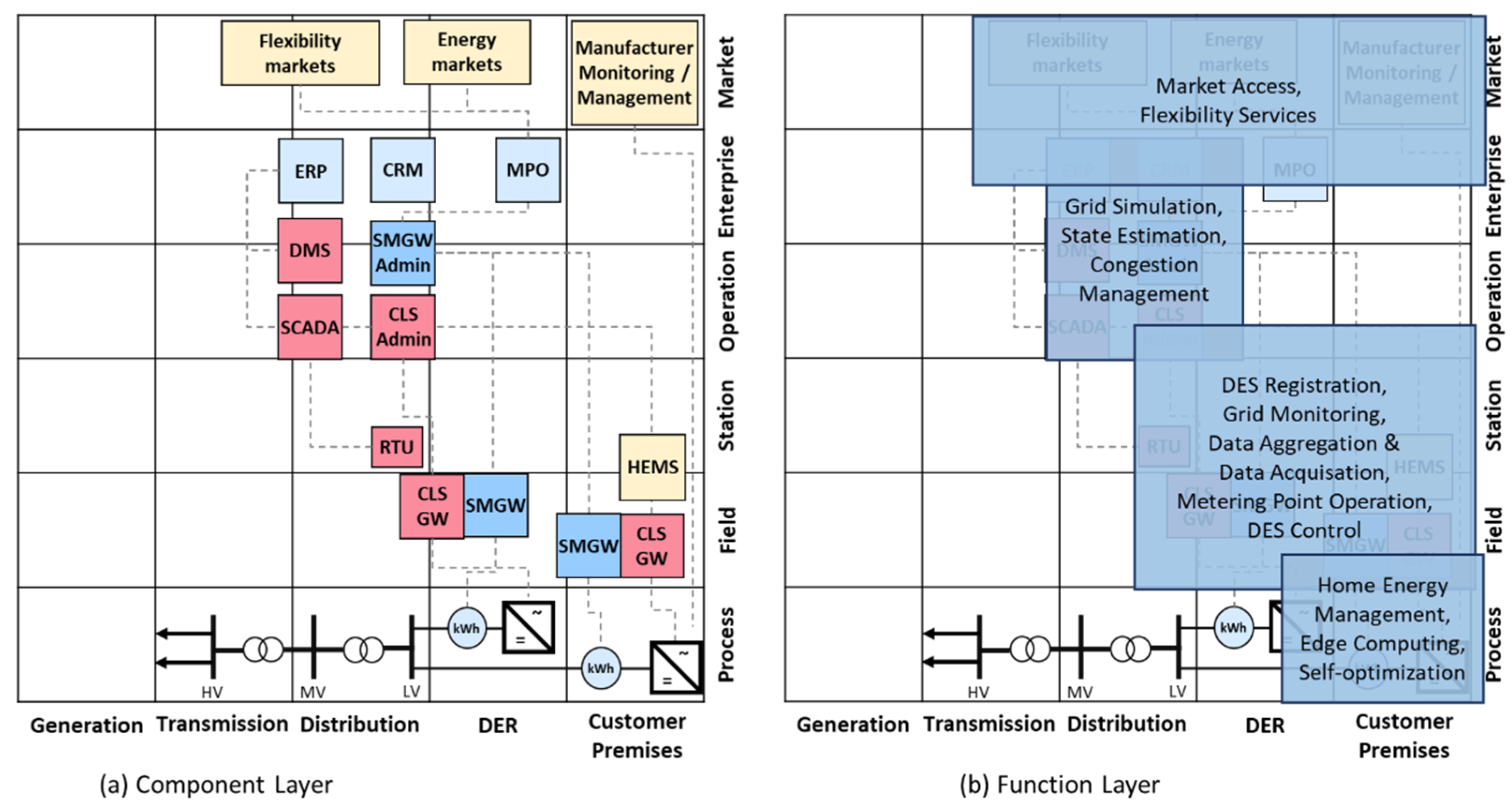
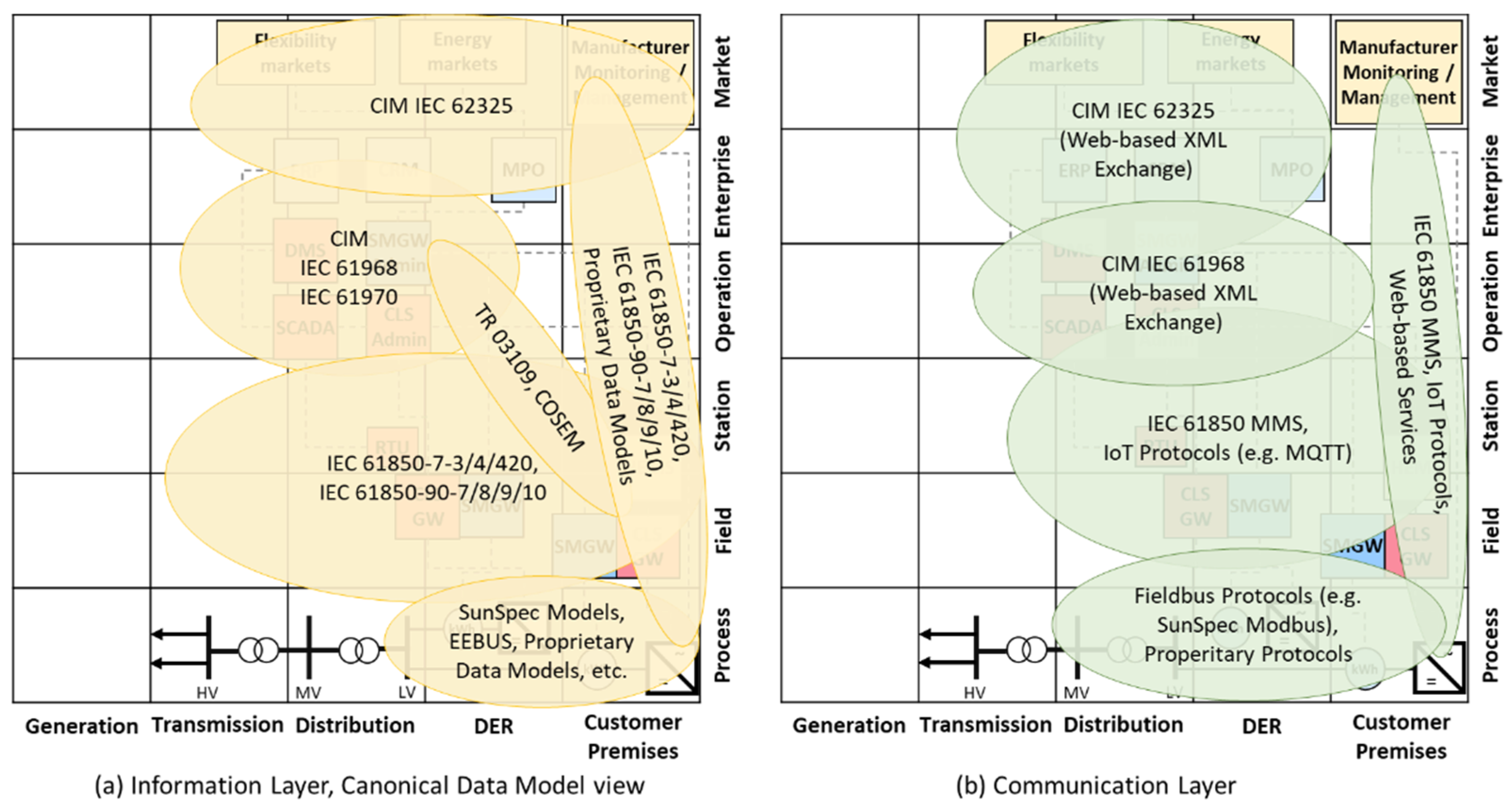


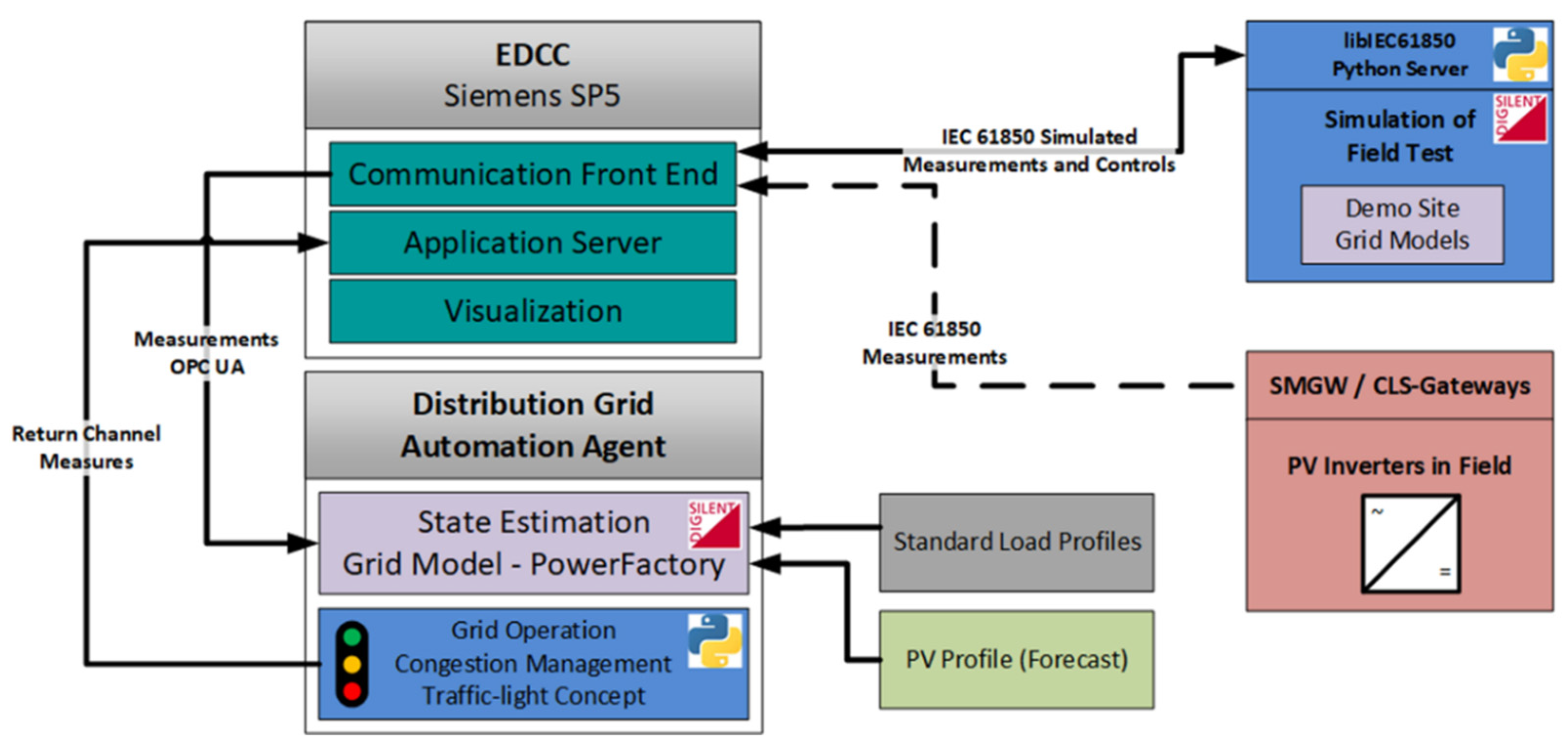

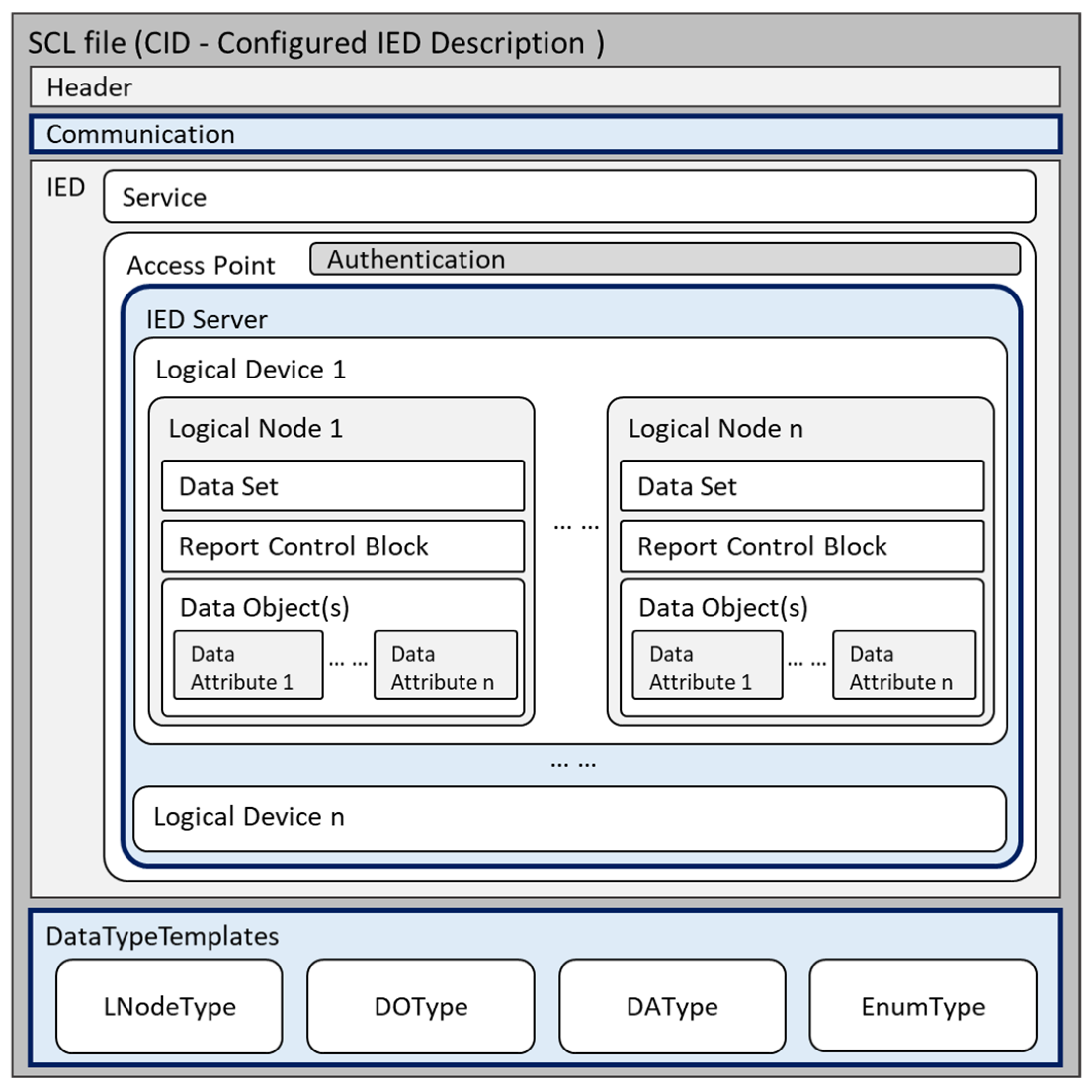
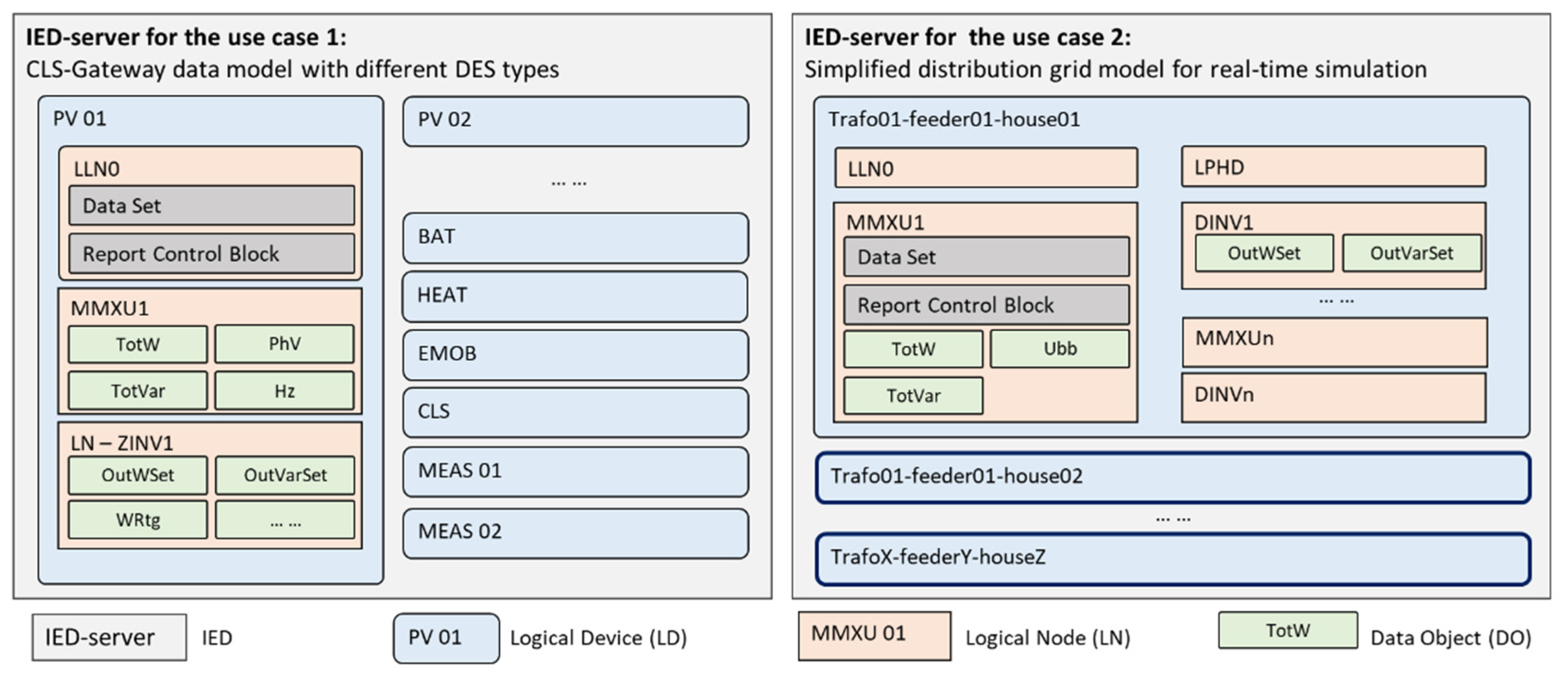


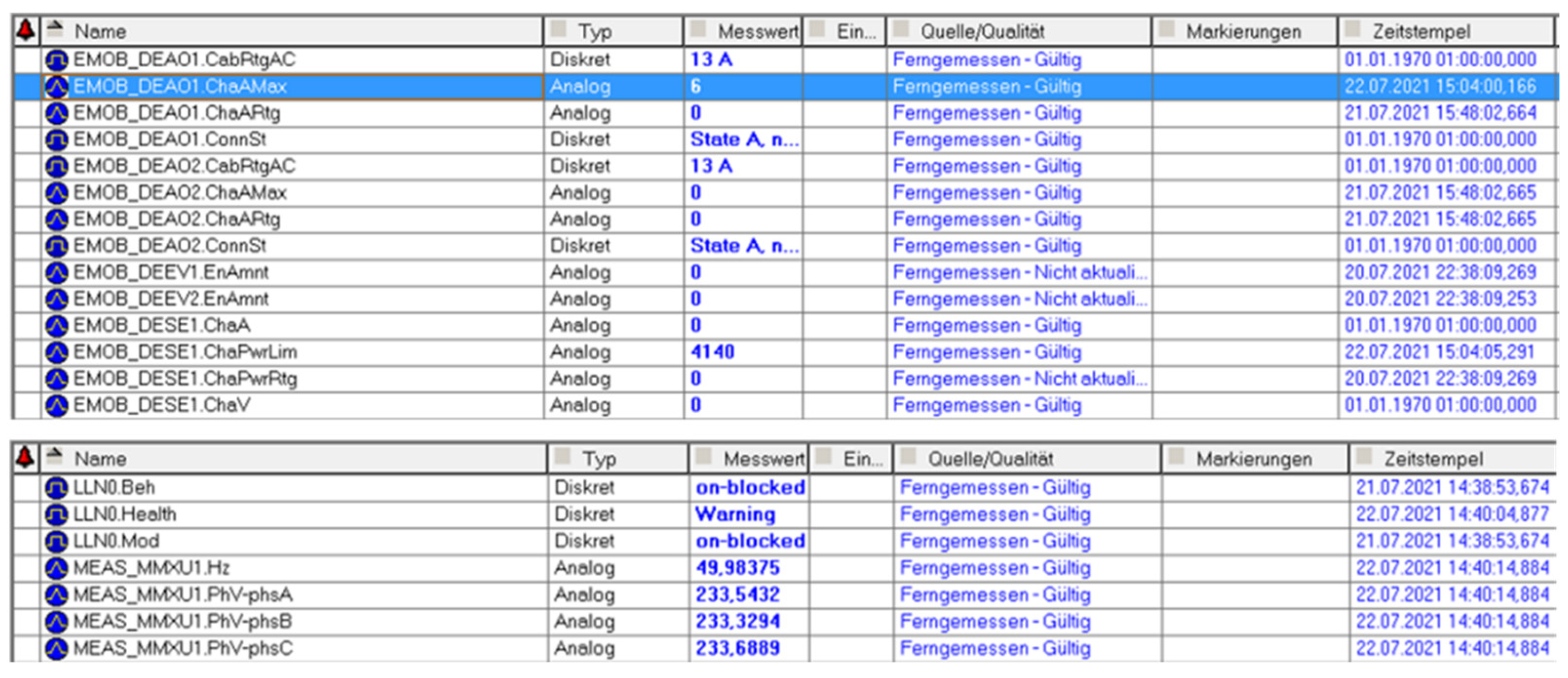
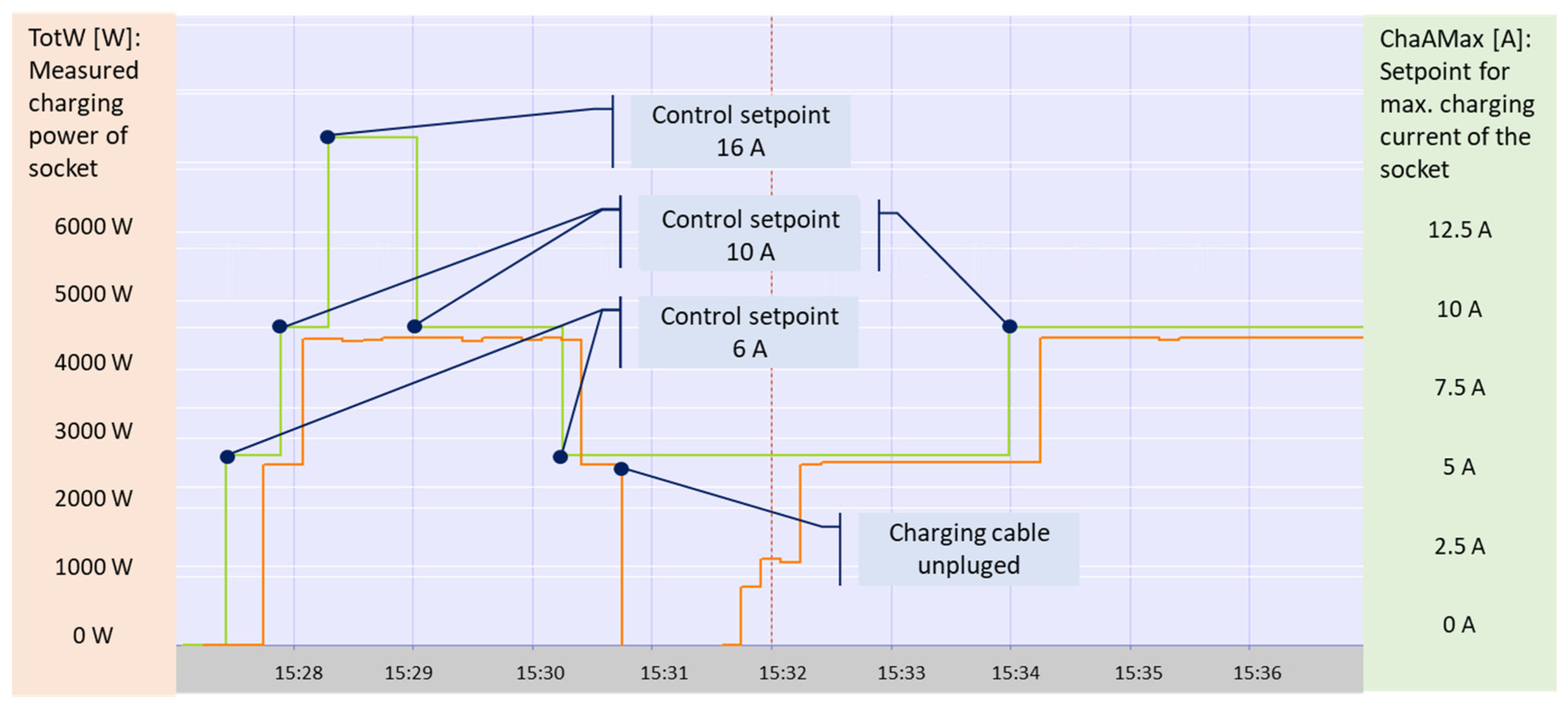

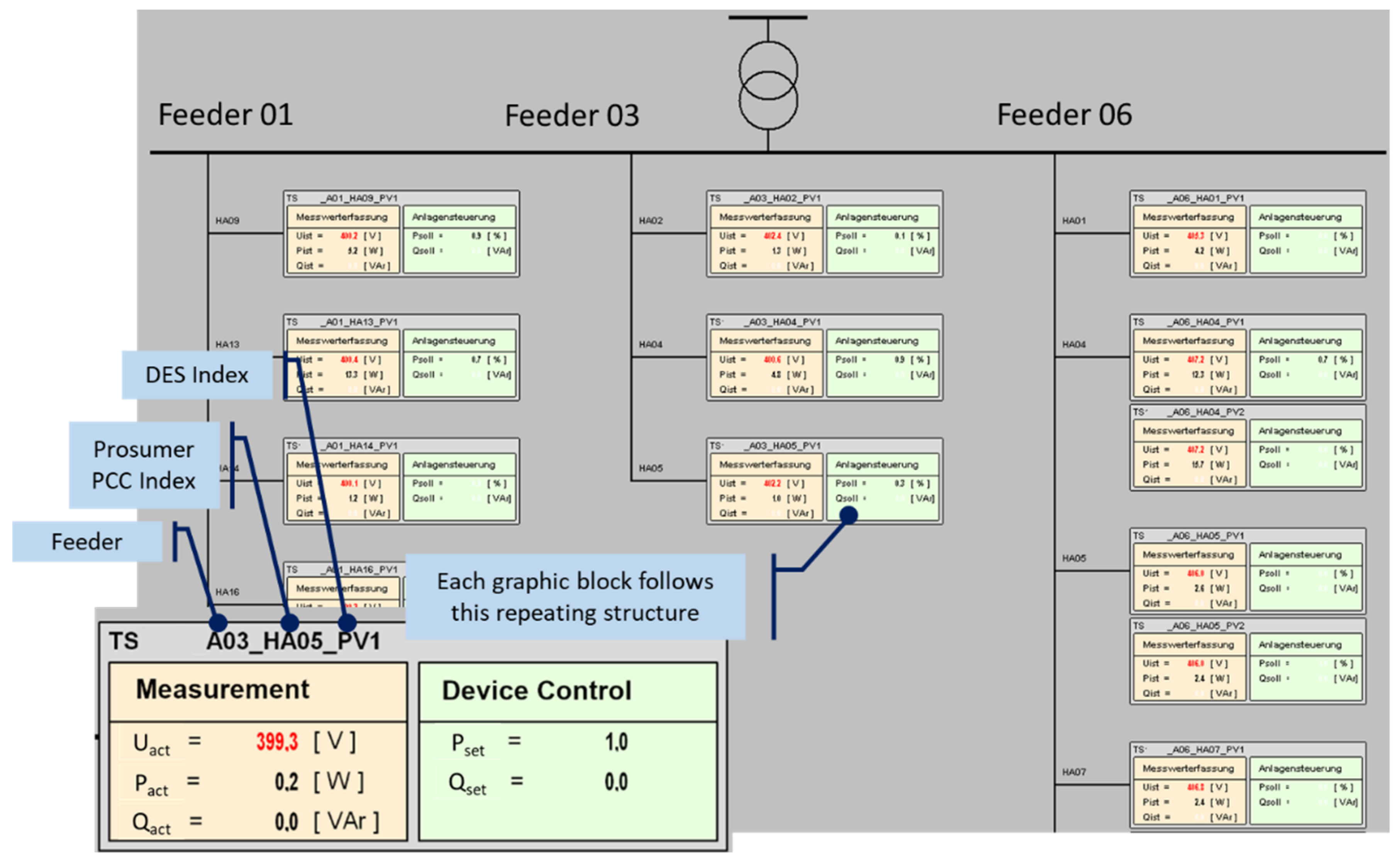
| Data Model | Data Structure | Major Use Case | DES Integration | Communication Type |
|---|---|---|---|---|
| IEC 60870-5-104 telegram [30] | Signal-oriented | Telecontrol equipment and system | No DES implementation | TCP/IP |
| IEC 61850 data model [31,32] for GOOSE [33]/SV [34] | Hierarchical, self-described | Substation automation | No DES specifications | broadcast/multicast on Ethernet/IP |
| IEC 61850 data model [31,32,35] for MMS [33,36] | Hierarchical, self-described | Substation automation, DER integration | Extensions for most DES types | TCP/IP, MMS |
| Common Information Model (CIM), IEC 61968/61970/62325 [37] | Hierarchical, self-described | Standardized, object-oriented data exchange | Specifications for most DES included or self-defined | Web-service [38] |
| ENTSO-E CGMES CIM, IEC 61968/61970 [39] | Hierarchical, self-described | Grid model exchange between TSOs for power flow analysis | Less considered | Web-service |
| IEEE 1815/DNP3 [40] | Hierarchical, signal-oriented | SCADA communication | No DES specification | Serial, TCP/IP, UDP/IP |
| IEEE2030.5/Smart Energy Profile 2.0 [41] | Function sets with dependencies, REST architecture | Smart energy IoT, smart home | Adoption in CA Rule 21 | REST on TCP/IP |
| Modbus TCP 1 mapping table | Tabular structure | Supervision and control of automation equipment | No DES specification | TCP/IP |
| SunSpec Modbus model [42] | Tabular structure with XML/JSON encoding | Communication to PV and BESS | DER management for entities by the 700 series | TCP/IP |
| OPC UA 2 information model | Hierarchical, platform-independent | Subscription of measurements | No DES specification | TCP/IP, Webservice, pub/sub |
| MQTT 3 message | Single messages, hierarchy by topics | IoT messaging, smart home | No DES specification | TCP/IP-based Pub/sub |
| Apache-Kafka 4 event | Hierarchical, event-driven | Industrial IoT, real-time | No DES specification | TCP/IP-based Pub/sub |
| EEBus 5 SPINE model | Hierarchical, XML/JSON encoding | IoT, smart home | Specifications for DER and grids | WebSockets on UDP/IP and TCP/IP |
| DES Parameter Category | Information Type | Example Parameter | Application Purpose |
|---|---|---|---|
| System hardware metadata | Static system information | Device manufacturer | DES registration |
| System software metadata | Dynamic system information | Software version | DES maintenance |
| Geographical reference | Geographical information | GPS coordinate | Grid planning, grid operation |
| Measured values | Measurements | Inverter feed-in power | Grid operation, invoicing |
| Device status information | Measurements | Battery state-of-charge | Grid operation, DES operation |
| Control parameters | Control setpoint/settings | Inverter feed-in power limitation | Grid operation, DES operation |
| Schedule | External input | Intra-day operation plan | Forecast service, grid operation, local DES control |
| System owner information | Static/dynamic system information | System owner ID | DES registration, grid planning, invoicing, customer service |
| Market information | External input | Metering location, market access | Invoicing, energy market |
| Information on other ancillary services | Static/dynamic system information | System control setting, flexibility | Grid operation, flexibility market |
| Component | Type | Description |
|---|---|---|
| EDCC | Hardware & software | SCADA at THU as the target data system of the data model integration process |
| libiec61850 library [70] | Software package | An open-source C-code library for IEC 61850 modeling, which was compiled in a Python library [71] |
| Python 3.7 | Programming language | An open-source programming language used for the implementation of the automation algorithm |
| IEC 61850 data model of a test area | SCL data model | IEC 61850 data model representing the simplified grid topology of a village in a LV distribution grid |
| IEC 61850 data model of a CLS gateway | SCL data model | An open-source IEC 61850 data model representing a CLS gateway that is capable to communicate with different DES types |
| CLS gateways | Hardware & software | Physical CLS gateways commissioned in the field with dockerized 1 open-source software [72] and telecommunication functions |
| PowerFactory grid simulation | Software | Widely used power grid simulation software with a Python automation interface [73] |
| Simulated IED server | Software | Virtual IED server implemented using libiec61850 library including interface with PowerFactory [71] |
| Real-time simulation environment | Software & real-time environment | Simulation environment developed at THU based on PowerFactory and EDCC [74] |
| IED Scout [75] | Software | A commercial IEC 61850 test and integration tool, here used for export of SCL data model |
| ICD Designer [76] | Software | A commercial software application for the creation of IEC 61850-compliant data model |
| CDC Type | Description | Main Purpose |
|---|---|---|
| ASG | Analogue setting | analogue settings |
| APC | Controllable analogue process value | control |
| DPL | Device nameplate | description information |
| ENC | Controllable enumerated status | control |
| ENG | Enumerated status setting | status settings |
| ENS | Enumerated status | status information |
| INC | Controllable integer status | control |
| ING | Integer status setting | status settings |
| INS | Integer status | status information |
| LPL | Logical node nameplate | description information |
| MV | Measured value | measurand information |
| MYX | Phase to ground/neutral related measured values of a three-phase system | measurand information |
| SPC | Controllable single point | control |
| SPG | Single point setting | status settings |
| SPS | Single point status | status information |
| FC Type | Semantic | Example | Description of the Example |
|---|---|---|---|
| MX | Measurands (analogue values) | MMXU.TotW.mag | Measurement of total active power |
| SP | Setting (outside setting group) | ZINV.outWSet.setMag | Control setpoint for inverter active power |
| ST | Status information | DSTO.OpTmh.stVal | Total operation time of a storage system |
| Validation Step | Validated by | Validation Contents |
|---|---|---|
| Data type templates | IEC 61850 definition | DO type, DA type, LN type |
| IED settings | IEC 61850 definition | IED type and services |
| IED structure | IEC 61850 MMS definition | DO instances, data sets, RCBs |
| Data model extent | counting | Number of LN, DO, DA and configured RCBs |
| XML structure | XML schema | Syntax check of the XML structure |
| Validation Criteria | Validated by | Validation Contents |
|---|---|---|
| CDC type | Parsing logic of edccADMID | Is the CDC type supported by the EDCC? |
| CFE parameter type | Parsing logic of edccADMID | Is the signal type supported by the EDCC? |
| RCB structure | Mapping logic of edccADMID | Does the structure of the RCBs follow the predefined nomenclature of edccADMID? |
| RCB contents | Mapping logic of edccADMID | Can the DAs in a RCB be recognized as CFE signals and transmitted to the EDCC? |
| XML structure | EDCC model manager | Does the XDF/XML contain syntax errors? |
| LINK elements | EDCC model manager | Can the LINK elements correctly be interpreted? |
| GUID validity | EDCC model manager | Are the GUIDs unique IDs? |
| object conflict | EDCC model manager | Does the imported XDF/XML have conflicts with existing objects in the EDCC? |
Publisher’s Note: MDPI stays neutral with regard to jurisdictional claims in published maps and institutional affiliations. |
© 2022 by the authors. Licensee MDPI, Basel, Switzerland. This article is an open access article distributed under the terms and conditions of the Creative Commons Attribution (CC BY) license (https://creativecommons.org/licenses/by/4.0/).
Share and Cite
Chen, S.; Ebe, F.; Morris, J.; Lorenz, H.; Kondzialka, C.; Heilscher, G. Implementation and Test of an IEC 61850-Based Automation Framework for the Automated Data Model Integration of DES (ADMID) into DSO SCADA. Energies 2022, 15, 1552. https://doi.org/10.3390/en15041552
Chen S, Ebe F, Morris J, Lorenz H, Kondzialka C, Heilscher G. Implementation and Test of an IEC 61850-Based Automation Framework for the Automated Data Model Integration of DES (ADMID) into DSO SCADA. Energies. 2022; 15(4):1552. https://doi.org/10.3390/en15041552
Chicago/Turabian StyleChen, Shuo, Falko Ebe, Jeromie Morris, Heiko Lorenz, Christoph Kondzialka, and Gerd Heilscher. 2022. "Implementation and Test of an IEC 61850-Based Automation Framework for the Automated Data Model Integration of DES (ADMID) into DSO SCADA" Energies 15, no. 4: 1552. https://doi.org/10.3390/en15041552
APA StyleChen, S., Ebe, F., Morris, J., Lorenz, H., Kondzialka, C., & Heilscher, G. (2022). Implementation and Test of an IEC 61850-Based Automation Framework for the Automated Data Model Integration of DES (ADMID) into DSO SCADA. Energies, 15(4), 1552. https://doi.org/10.3390/en15041552






